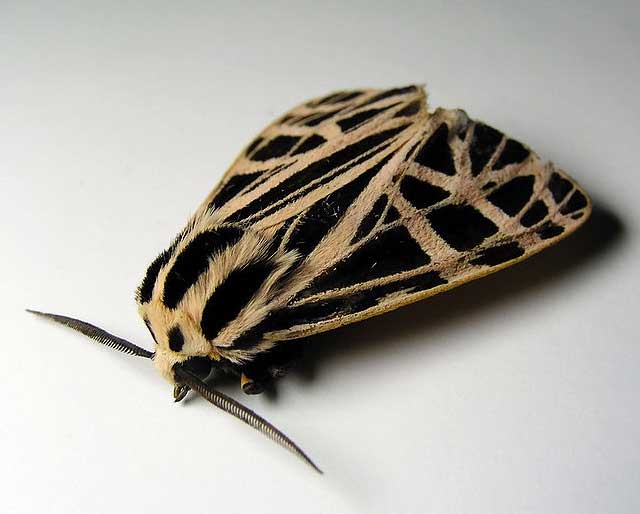
Grammia (Grammia) parthenice (*)
Superregnum: Eukaryota
Cladus: Unikonta
Cladus: Opisthokonta
Cladus: Holozoa
Regnum: Animalia
Subregnum: Eumetazoa
Cladus: Bilateria
Cladus: Nephrozoa
Cladus: Protostomia
Cladus: Ecdysozoa
Cladus: Panarthropoda
Phylum: Arthropoda
Subphylum: Hexapoda
Classis: Insecta
Cladus: Dicondylia
Subclassis: Pterygota
Cladus: Metapterygota
Infraclassis: Neoptera
Cladus: Eumetabola
Cladus: Endopterygota
Superordo: Panorpida
Cladus: Amphiesmenoptera
Ordo: Lepidoptera
Subordo: Glossata
Cladus: Coelolepida
Cladus: Myoglossata
Cladus: Neolepidoptera
Infraordo: Heteroneura
Cladus: Eulepidoptera
Cladus: Ditrysia
Cladus: Apoditrysia
Cladus: Obtectomera
Cladus: Macroheterocera
Superfamilia: Noctuoidea
Familia: Erebidae
Subfamilia: Arctiinae
Tribus: Arctiini
Subtribus: Arctiina
Genus: Grammia
Subgenus: Grammia (Grammia)
Species: Grammia (Grammia) parthenice
Name
Grammia (Grammia) parthenice (Kirby, 1837)
Synonyms
Callimorpha parthenice Kirby, 1837
Arctia saundersii Grote, 1864
Arctia intermedia Stretch, 1873
Arctia stretchii Grote, 1875
Arctia approximata Stretch, 1885
Arctia intermedia var. circa Stretch, 1906
References
Ferguson, Douglas C. & B. Christian Schmidt, 2007, Zootaxa 1405: 39–49 [1]
Schmidt, B.C. 2009: Taxonomic revision of the genus Grammia Rambur (Lepidoptera: Noctuidae: Arctiinae). Zoological journal of the Linnean Society, 156: 507–597. DOI: 10.1111/j.1096-3642.2008.00496.x
The parthenice tiger moth is a moth of the family Erebidae. It is found in south-eastern Canada, and the eastern United States. The moths are common in fields and woodland edges from June to late September. The moth is nocturnal and is attracted to light sources.[2]
The wingspan is about 7.5 cm (3 in). The fore wings and the thorax are black, with a complex network of bold white veining and white margins. The hind wings and abdomen are orange-pink with black patches. The brightly striped pattern of the wings has inspired the common name of tiger moth. Their bodies are stout and furry.[2]
Caterpillars of the species are dark with contrasting bright markings and covered with stiff hairs. They are toxic like the adults. Many species of tiger moths contain toxic substances, so the bright patterns of both adults and larvae serve as a warning to predators. Contact with the hairy bodies of these caterpillars can cause skin irritation. Tiger moths have a well-developed hearing organ, or tympanum, on each side of the thorax. The larvae feed on various low-growing plants, including dandelion, Vernonia, and thistles.
This species was formerly a member of the genus Grammia, but was moved to Apantesis along with the other species of the genera Grammia, Holarctia, and Notarctia.[3][4]
References
"Species Apantesis parthenice - Parthenice Tiger Moth - Hodges#8196". bugguide.net. Retrieved 2010-01-12.
"Archived copy". Archived from the original on June 11, 2010. Retrieved January 8, 2010.Retrieved 2010-1-8
Rönkä, Katja; Mappes, Johanna; Kaila, Lauri; Wahlberg, Niklas (2016). "Putting Parasemia in its phylogenetic place: a molecular analysis of the subtribe Arctiina (Lepidoptera)". Systematic Entomology. 41 (4): 844–853. doi:10.1111/syen.12194.
Schmidt, B. Christian; Lafontaine, J. Donald; Troubridge, James T. (2018). "Additions and corrections to the check list of the Noctuoidea (Insecta, Lepidoptera) of North America north of Mexico IV". ZooKeys (252): 241–252. doi:10.3897/zookeys.252.28500. PMC 6189224. PMID 30337831.
External links
Moths and Butterflies of North America
Retrieved from "http://en.wikipedia.org/"
All text is available under the terms of the GNU Free Documentation License

